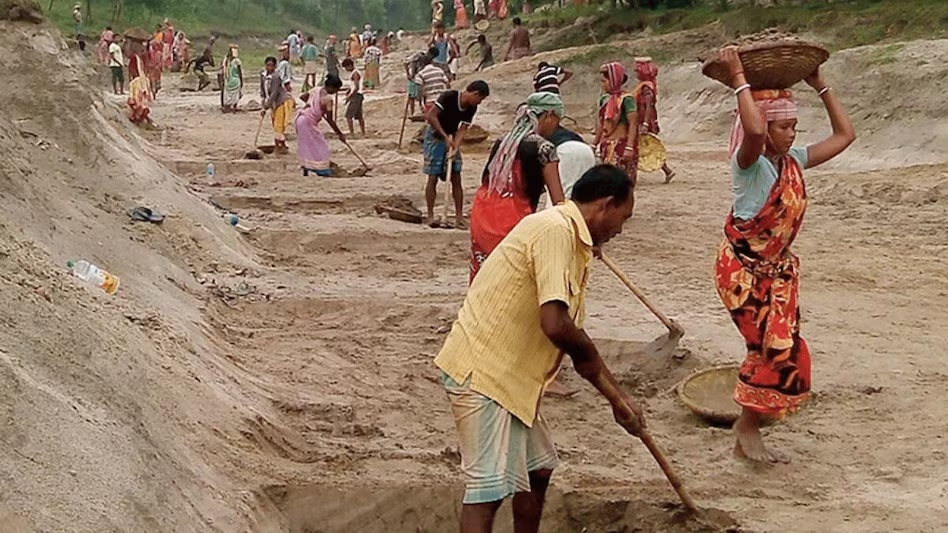Description

Copyright infringement not intended
Picture Courtesy: https://simple.wikipedia.org/wiki/Proportional_representation
Context: The Lok Sabha elections in India have revealed that the ruling National Democratic Alliance (NDA) has won 293 seats with a 43.3% vote share, while the Opposition bloc INDIA secured 234 seats with a 41.6% vote share. Other regional parties and independents polled around 15% but ended up with only 16 seats in total.
Proportional Representation (PR)
- Proportional Representation (PR) is a system used in electoral democracies to ensure that political parties are represented in legislative bodies in proportion to their share of the popular vote. Unlike the First Past the Post (FPTP) system, where only the candidate with the most votes in a constituency wins a seat, PR allocates seats based on the overall percentage of votes each party receives.
- This system aims to provide a more accurate reflection of the electorate's preferences and to ensure that minority viewpoints are represented.
- PR allocates seats in proportion to the number of votes received by each party or group. It involves voters selecting parties rather than individual candidates, and seats are then distributed based on the overall vote share each party receives.
Types of Proportional Representation
- List Proportional Representation (List PR): In this system, voters cast their vote for political parties rather than individual candidates. Seats are allocated to parties based on their overall share of the vote, and parties submit lists of candidates in order of preference to fill the seats won.
- Single Transferable Vote (STV): This system allows voters to rank candidates in order of preference. Seats are allocated based on a quota, with surplus votes from elected candidates and votes from eliminated candidates transferred to other candidates according to voters' preferences.
- Mixed-Member Proportional (MMP): MMP combines elements of both FPTP and PR systems. Voters cast two votes: one for a candidate in their local constituency (FPTP), and one for a political party. Additional seats are then allocated to ensure proportionality based on the party vote.
Advantages of Proportional Representation
- Ensures Fair Representation of Minority Groups: PR systems provide better opportunities for minority and smaller political groups to gain representation in the legislature, ensuring a more inclusive political landscape.
- Reduces Wasted Votes: Since seats are allocated in proportion to the number of votes received, most votes contribute to the election of representatives, leading to fewer wasted votes and greater voter satisfaction.
- Encourages Coalition Governments: PR often necessitates coalition governments, promoting broader consensus and more balanced policymaking as multiple parties must work together to form a government.
- Reflects Diverse Electorate: PR systems ensure that the composition of the legislature more accurately reflects the diverse preferences of the electorate, leading to policies that address a wider range of interests and concerns.
- Higher Voter Turnout: Knowing that their vote is more likely to count, voters may be more motivated to participate in elections, potentially increasing voter turnout.
- Discourages Gerrymandering: Since PR systems do not rely on single-member districts, the incentive for gerrymandering—manipulating electoral district boundaries for political gain—is reduced.
- Encourages Political Participation: PR systems can encourage greater political engagement and participation from smaller parties and independent candidates, fostering a more dynamic political environment.


Disadvantages of Proportional Representation (PR)
- Can Lead to Political Instability: PR systems can result in fragmented legislatures with many parties, making it challenging to form stable and cohesive governments. Coalition governments can be unstable and prone to frequent changes and disagreements.
- May Weak the Link Between Representatives and Constituents: In PR systems, especially those with large multi-member districts, the direct connection between representatives and their constituents can be weakened, reducing accountability.
- Can Result in the Proliferation of Small Parties: PR systems often lead to a greater number of small parties in the legislature, some with narrow or extreme agendas, complicating governance and legislative processes.
- Complexity in Voting and Counting: PR systems can be more complex for voters to understand and for officials to administer, leading to longer times to finalise election results and potential voter confusion.
- Difficulty in Forming Majority Governments: It is less likely for a single party to win an outright majority in PR systems, making it harder to form strong, decisive governments. Coalitions of multiple parties are often required and can be fragile.
- Potential for Extremist Parties to Gain Influence: Since even small parties can gain seats more easily, there is a risk that extremist parties with a small but dedicated base of support can gain representation and influence in the legislature.
- Increased Power of Party Leadership: In some forms of PR, especially closed-list systems, party leaders have significant control over candidate selection and their order on party lists, concentrating power within party leadership.
- Complicated Coalition Negotiations: Forming coalitions often involves prolonged negotiations among various parties, delaying the formation of a government and policy implementation, and creating fragile coalitions vulnerable to breakdowns.
Several countries around the world utilise Proportional Representation (PR) in their electoral systems
Germany
- Germany uses a Mixed Member Proportional Representation (MMPR) system. Under this system, voters cast two votes: one for a candidate in their local constituency and one for a political party.
- Half of the seats in the Bundestag are filled through direct constituency elections, while the other half are filled based on the party vote to ensure proportionality.
New Zealand
- New Zealand also employs MMPR. Similar to Germany, voters in New Zealand have two votes—one for a local representative and one for a political party.
- The Parliament is composed of both directly elected constituency members and members chosen from party lists to ensure proportional representation.
Netherlands
- The Netherlands uses a party list PR system, where voters vote for a political party rather than individual candidates.
- Seats in the Dutch Parliament are allocated to parties based on their share of the vote, with a minimum threshold required for representation.
Belgium
- Belgium also utilises party list PR. Seats in the Belgian Parliament are allocated to parties based on their share of the vote in each electoral district, with a minimum threshold required for representation.
South Africa
- South Africa uses a party list PR system for its National Assembly elections. Seats are allocated to parties based on their share of the national vote, with each party presenting a list of candidates in order of preference.
PR in Legislative Assemblies
- Rajya Sabha (Council of States): Members are elected by the elected members of State Legislative Assemblies using the Single Transferable Vote (STV) system. This ensures that the composition of the Rajya Sabha more accurately reflects the political diversity of the state legislatures.
- State Legislative Councils: Some states have legislative councils (Vidhan Parishad) whose members are also elected through the STV system, allowing for a proportionate reflection of the political landscape within the state.
|
Comparison of FPTP and Proportional Representation (PR)
|
|
First Past the Post (FPTP)
|
Proportional Representation (PR)
|
|
A candidate who gets one vote more than the other candidate in a constituency is the winner. It is also known as the simple majority system.
|
Seats are assigned to political parties in proportion to the number of votes received, ensuring fair representation based on vote share.
|
|
The country is divided into geographical units known as constituencies.
|
Large geographical areas are treated as constituencies, with representation based on overall vote distribution.
|
|
Used in direct elections to the Lok Sabha and State Legislative Assemblies.
|
Used to elect the President of India, Vice President, and members of the Rajya Sabha, among others.
|
|
Votes are cast for individual candidates.
|
Votes are cast for political parties.
|
PR in Local Government Elections
- Certain local government bodies in India also use PR to ensure fair representation of various political groups. This is particularly important in municipal corporations where diverse urban populations require inclusive governance.
Implementation of PR in India
Constitutional Provisions
- Article 80: Pertains to the composition and election of members to the Rajya Sabha using PR through the STV system.
- Article 171: Relates to the composition and election of members to state legislative councils, also using PR through the STV system.
Legal Framework
- The Representation of the People Act, 1951, outlines the procedures for conducting elections, including those using PR. It provides detailed guidelines for the election of members to the Rajya Sabha and state legislative councils, ensuring transparency and fairness in the electoral process.
Challenges and Criticisms
Regionalism and Fragmentation of Politics
- One significant criticism of PR is that it can exacerbate regionalism and the fragmentation of politics. By enabling the representation of a large number of smaller parties, PR systems can lead to highly fragmented legislatures, complicating the formation of stable governments.
Complexity in Coalition-building
- PR systems often result in coalition governments. While coalitions can be more inclusive, they are also more complex to form and maintain. Coalition-building requires continuous negotiation and compromise, which can slow down decision-making and governance.
Manipulation of Party Lists
- In closed-list PR systems, party leaders have substantial control over the order of candidates on the party list. This can lead to favouritism and manipulation, where candidates loyal to party leaders are favoured over those with broader public support, potentially undermining democratic principles.
Potential Future Developments in PR in India
- Broader Adoption Across Different Levels of Government: Expanding the use of PR from local bodies and upper houses to potentially include state legislative assemblies and the Lok Sabha to enhance representativeness at all levels of government.
- Integration with Digital Voting Systems: Leveraging technology to streamline the PR voting process, making it more accessible and efficient for voters and electoral authorities.
- Educational Campaigns on PR: Conducting public awareness campaigns to educate voters on the mechanics and benefits of PR, ensuring informed participation in the electoral process.
- Pilot Programs and Gradual Implementation: Initiating pilot programs in select states or constituencies to test and refine the PR system before broader implementation.

Conclusion
- Proportional Representation holds promise for making India's electoral system more inclusive and representative. While challenges exist, such as potential political instability and complexity in coalition-building, thoughtful reforms and gradual implementation can mitigate these issues. By ensuring fairer representation of diverse political views, PR can strengthen India's democratic foundations, fostering a more equitable political landscape. The future of PR in India depends on careful consideration of its benefits and challenges, continuous refinement, and commitment to democratic principles.
Source:
The Hindu
Wikipedia
fairvote.org
|
PRACTICE QUESTION
Q. Consider the following Statements:
1. Proportional Representation (PR) allocates seats in a legislative body based on the proportion of votes each political party receives nationally, ensuring fair representation regardless of geographic location.
2. Unlike the FPTP system, where winning candidates in individual constituencies take all the seats, PR allocates seats to parties based on their overall share of the vote across the entire country or region.
3. In a PR system, voters cast their ballots for political parties rather than individual candidates.
4. Mixed-member proportional Representation (MMPR) combines elements of both PR and the FPTP system by allowing voters to cast two votes: one for a candidate in their constituency and one for a political party.
How many of the above statements are correct?
A) Only one
B) Only two
C) Only three
D) All four
Answer: D
|












